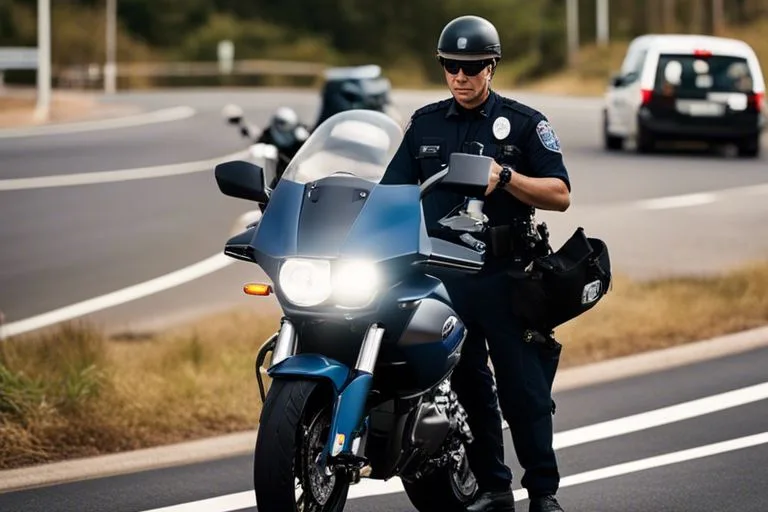If you find yourself in a situation where a law enforcer seizes your motorcycle in the Philippines, it is important to know the detailed procedures they are required to follow. From issuing a receipt to securing the motorcycle and documenting the seizure, there are specific steps that must be taken to ensure that the process is conducted lawfully and respectfully.
In this informative blog post, we will explore the crucial steps that law enforcers typically need to follow when seizing a motorcycle, thus, providing you with a clear understanding of your rights and what to expect in such a circumstance.
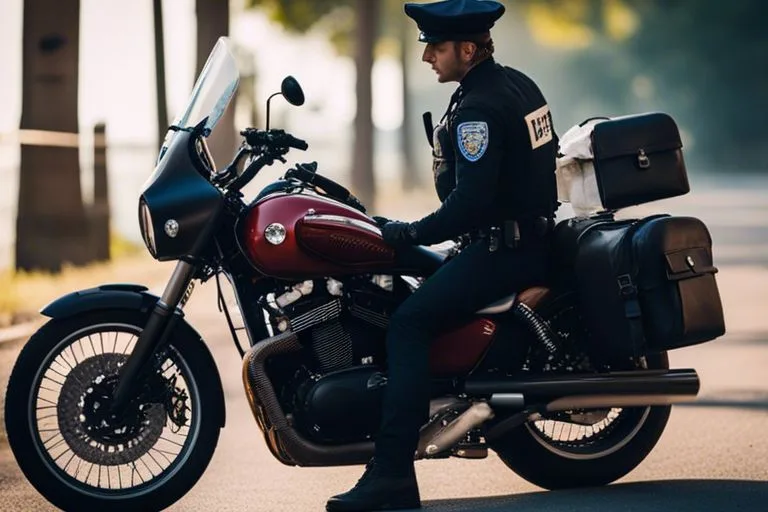
Key Takeaways:
- Receipt Issuance: Law enforcers should provide a receipt to the motorcycle owner acknowledging the seizure.
- Owner Notification: The owner should be informed of the reason for the seizure and any relevant laws violated.
- Inventory Documentation: The law enforcer must document all items found on or inside the motorcycle during the seizure.
- Secure Handling: The motorcycle should be properly secured to prevent theft or damage while in custody.
- Legal Compliance: Law enforcers must follow specific legal procedures outlined by Philippine law, especially in cases involving crimes.
- Documentation: Detailed records, including paperwork and evidence, must be maintained throughout the seizure process.
- Respect Rights: It is crucial for law enforcers to act in accordance with the law and ensure that the owner’s rights are respected at all times.
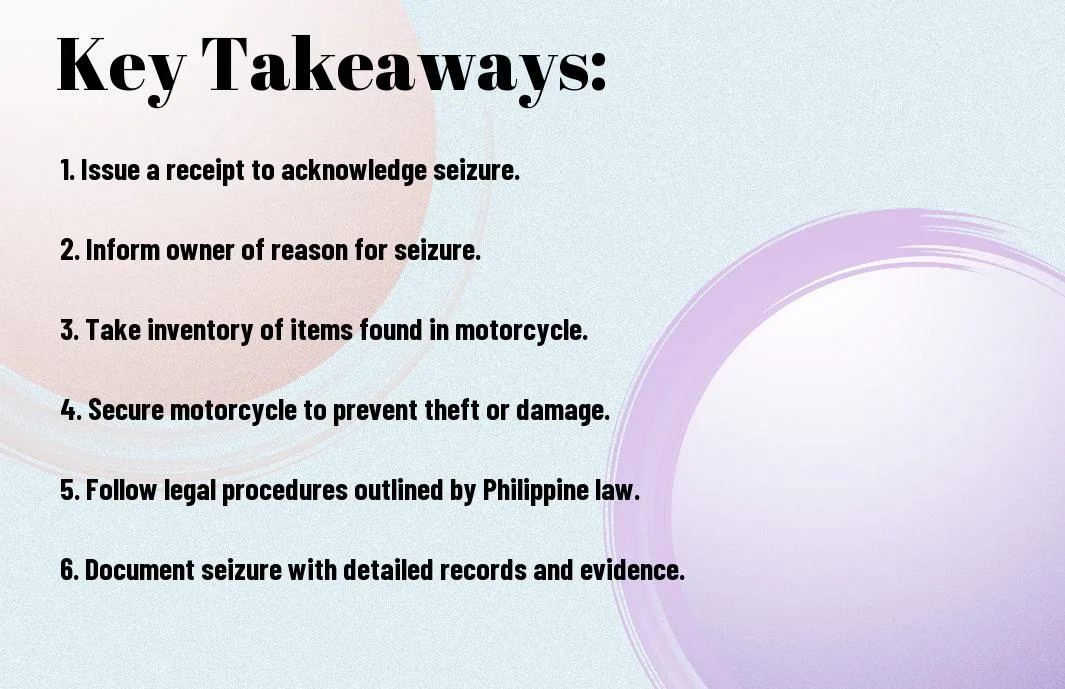
Legal Basis for Seizure
Overview of Traffic and Transportation Laws
Some of the most important laws that govern the seizure of motorcycles in the Philippines are related to traffic and transportation. These laws outline the rules and regulations that motorcycle owners must adhere to, and violations of these laws can lead to the seizure of the vehicle.
Circumstances under which a law enforcer can seize a motorcycle
For an authorized law enforcer to seize a motorcycle in the Philippines, there must be valid reasons and legal grounds. An officer can seize a motorcycle if it is suspected to be involved in a crime, if the owner is found to be in violation of traffic laws, or if the motorcycle is deemed to be a threat to public safety.
Basis: The seizure of a motorcycle is typically based on the enforcement of laws and regulations, and the officers must have clear justification for taking such action. By following the necessary legal procedures and citing the appropriate laws, law enforcers ensure that the seizure is done lawfully and in the best interest of public safety.
In the Philippines, Republic Act No. 11235, otherwise known as the Motorcycle Crime Prevention Act,1 describes the situations where a motorcycle can be confiscated and impounded, to wit:
- Driving Without a Number Plate or Readable Number Plate2
- Use of a Motorcycle in the Commission of a Crime3
On the other hand, in MC-105-89 of the Metro Manila Development Authority (MMDA), the following are the circumstances where a motorcycle (or vehicle) may be impounded,4 to wit:
- Unregistered/Improperly registered/delinquent or invalid registration
- Unregistered substitute or replacement motor, vehicle engine, engine block or chassis
- Unauthorized change of color or configuration
- Operating, allowing the operation of a motor vehicle with a suspended or revoked Certificate of Registration
- Using license plates different from the body number
- Illegal Transfer of plates, tags, or stickers
- Violations involving absence of required parts, accessories or devices or defective parts, accessories or devices which pose danger to the public
- Authorized route not properly painted
- Unauthorized/improvised number plates
- Failure to paint on vehicle business or trade name
- Failure to paint required markings
- No body number for Public Utility Vehicle (PUV)
- Using radio or stereo in violation of existing regulation or without the necessary permit, or in breach of the condition in permit regulation.
- Installation of jalousies, curtains, dim colored lights, strobe lights, dancing lights or similar lights, colored tinted or painted windshield on window glass on “for hire” vehicles
- Driving without a license plate
- Fake drivers license/ Ordinance Violation Receipt (OVR)
- Fake sticker
- Fake license plate
- Fake Official Receipt and Certificate of Registration
- Tampered documents pertaining to franchising, registration and licensing
- Failure to present any document regarding motor vehicle ATTA
- Breach of Franchise Conditions
- Improper use of drivers license
- Expired drivers license
- Expired Traffic Violation Receipt
- PUV
In addition, the following violations shall also cause the impounding of the motor vehicle:
- Driving without a license plate
- Fake drivers license/TVR
- Fake sticker
- Fake license plate
- Fake Official Receipt and Certificate of Registration
- Tampered documents pertaining to franchising, registration and licensing
- Failure to present any document regarding motor vehicle ATTA
- Breach of Franchise Conditions
- Improper use of drivers license
- Expired drivers license
- Expired Traffic Violation Receipt
- Involved in Accidents
- Illegally Parked
Distinction between temporary custody and permanent confiscation
Laws in the Philippines differentiate between temporary custody and permanent confiscation of seized motorcycles. Temporary custody is usually applied when the motorcycle is needed for investigative purposes, while permanent confiscation may occur when the motorcycle is linked to serious offenses or repeat violations.
Legal: Understanding the nuances of temporary custody and permanent confiscation is crucial in ensuring that the rights of motorcycle owners are respected, and that the proper legal procedures are followed during and after the seizure process.
What should a law enforcer do upon seizing a motorcycle from a traffic offender?
When a law enforcement officer confiscates a motorcycle from someone who has violated traffic laws, they should initially issue a citation or violation ticket to officially record the infringement.
This document functions as an authoritative record and notifies the wrongdoer of the transgression and its repercussions. Subsequently, it is important to apprise the wrongdoer of the rationale behind the confiscation, explicitly elucidating the traffic transgression that precipitated it and the legal ramifications entailed.
The law enforcement officer should thereafter conduct a thorough examination of any objects discovered on or within the motorcycle, meticulously recording registration documents and any other pertinent information.
Subsequently, it is imperative to securely confiscate the motorcycle, adhering to appropriate protocols to safeguard against theft or harm. Ultimately, it is crucial for them to provide the offender with clear instructions regarding the subsequent actions, which encompass retrieving the motorcycle and resolving the traffic offense by paying any applicable fines or penalties. In general, following these measures guarantees fairness and openness in the seizure process.
Initial Encounter with Law Enforcement
Procedures for traffic stops and checkpoints
Enforcement of traffic laws in the Philippines is crucial for maintaining road safety. When law enforcers seize a motorcycle during a traffic stop or at a checkpoint, they are required to follow specific procedures to ensure that the rights of the owner are respected.
Evaluation of the scene
Making a quick assessment of the scene is important for law enforcers when seizing a motorcycle. This includes documenting any item found on or inside the motorcycle, securing the vehicle to prevent theft or damage, and informing the owner of the reason for the seizure, as well as any relevant laws that have been violated.
Communication with the motorcycle owner
Violations of traffic laws or regulations or the commission of crimes, as specified above, may lead to the seizure of a motorcycle by law enforcement in the Philippines. When communicating with the motorcycle owner, law enforcers must provide a receipt acknowledging the seizure, inform the owner of the reason for the seizure, and ensure that all necessary steps are taken in accordance with Philippine law.
Documentation at the Scene
Once again, when a law enforcer seizes a motorcycle in the Philippines, proper documentation at the scene is crucial. This involves issuing a receipt to the owner, informing them of the reason for the seizure, taking inventory of items found on the motorcycle, securing the vehicle, and following legal procedures. All details need to be accurately recorded to ensure transparency and accountability.
The objective of these is to apprise the owner or lawful possessor of the motorcycle and to abide by the constitutional rule of due process.
Recording the incident
Documentation of the incident is vital for legal purposes. Law enforcers must record the date, time, location, and reason for seizure in detail. Additionally, any items found on or inside the motorcycle should be documented for evidence purposes.
Issuing citations and notices
Depending on the reason for the confiscation, when an incident leads to the seizure of a motorcycle, law enforcers may need to issue citations or notices to the owner. These documents inform the owner of any violation committed, the reason for the seizure, and any legal procedures that will follow. It is imperative for the owner to be fully informed of the situation.
Filling out official reports
After an incident involving the seizure of a motorcycle, law enforcers must fill out official reports documenting the details of the seizure, depending on the grounds thereof. This includes providing summonses, statements from witnesses, and any other pertinent information related to the case. Every detail must be accurately recorded to ensure a thorough investigation process.
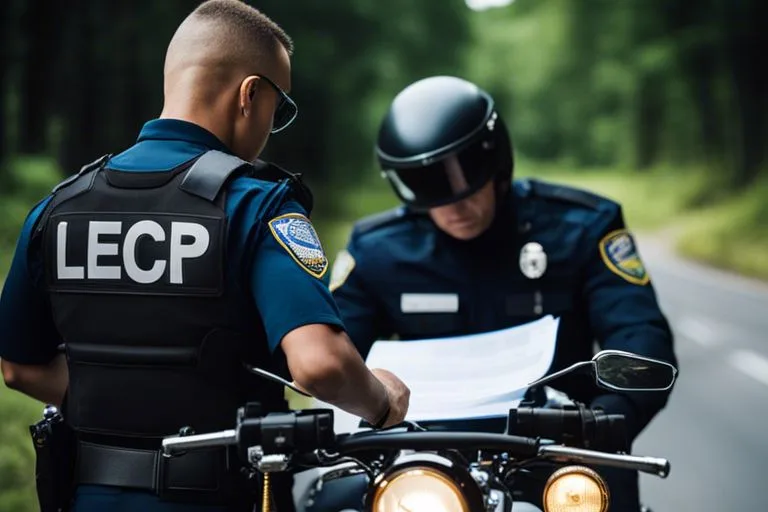
Seizure Procedure
Issuing a receipt
To ensure proper documentation, when a law enforcer seizes a motorcycle in the Philippines, they are required to issue a receipt to the owner. This receipt should contain essential details such as the reason for the seizure, date, time, location, and any relevant information related to the seizure.
Taking inventory
Taking inventory of items found on or inside the motorcycle at the time of the seizure is a crucial step in the process. This includes documenting registration papers, identification documents, or any other items present. In addition, documenting any contraband found is also necessary for legal purposes.
Securing the motorcycle
Securing the motorcycle following a seizure is vital to prevent theft or damage to items inside the motorcycle while it is in custody. This may involve impounding the motorcycle in a secure location to ensure its safety. It is imperative that proper measures are taken to protect the motorcycle during this period.
Notifying relevant parties
Issuing a notification to the relevant parties, including the owner of the motorcycle, about the reason for the seizure and any violated laws or regulations, is important. This step ensures transparency and the protection of the rights of all parties involved. Keeping thorough records of this communication is crucial for documentation purposes.
Owner’s Rights and Responsibilities
Immediate actions available to the owner
On the unfortunate event that your motorcycle gets seized by a law enforcer in the Philippines, it is crucial to act promptly. Except in cases where the motorcycle is utilized for the commission of a crime which shall be forfeited in favor of the government,5 under RA 11235, the owner of such motorcycle may redeem his or her seized motorcycle from the LTO upon proof of ownership, payment of the costs of seizure, and compliance with a number plate or readable number plate.6
Acquisition of the necessary documents for release
This involves obtaining and providing the correct documentation to the authorities in order to facilitate the release of your seized motorcycle. This typically includes providing registration papers, identification documents, or any other paperwork requested by the law enforcer. It is important to ensure all required documents are in order to expedite the process.
Understanding penalties and fines
The owner may also need to be aware of any penalties or fines that could be incurred due to the seizure of their motorcycle. Depending on the violation that led to the seizure, there may be additional penalties or fines that need to be addressed. It is important for the owner to understand these consequences and take appropriate action as necessary.
Post-Seizure Procedures for Law Enforcers
Keep What To Do During Vehicular Accidents and What to do if your motorcycle gets impounded in mind as we research the post-seizure procedures followed by law enforcers in the Philippines when seizing a motorcycle.
Managing the impounded property
Impounded property, such as a motorcycle, must be properly secured to prevent theft or damage while in the custody of the authorities. This involves storing the motorcycle in a secure location and ensuring that all items found on or inside the motorcycle are properly documented, including registration papers and identification documents. As per Philippine law, the law enforcer is required to issue a receipt to the owner acknowledging the seizure and informing them of the reason and location of the seizure.
Legal proceedings and hearings
Items seized during a motorcycle seizure may be crucial in legal proceedings and hearings. Maintaining detailed records of the seizure, including paperwork, photographs, and other evidence, is necessary. Depending on the circumstances, the law enforcer may need to follow specific legal procedures outlined by Philippine law to protect the owner’s rights, especially if the seizure is part of an investigation into a crime.
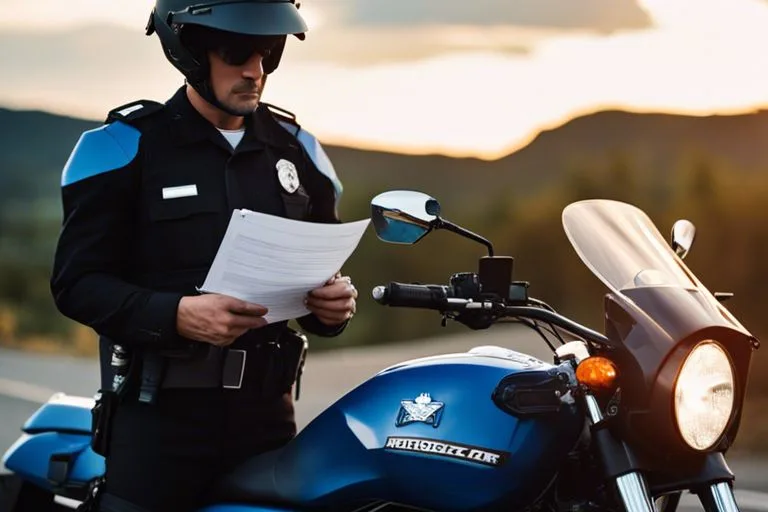
If the motorcycle is not used for the commission of a crime, the release thereof can still be processed. After being verified, identified, and properly documented, the person seeking the release of the motorcycle must obtain the permission of the court or any quasi-judicial agency (more apt in a preliminary investigation before the prosecutor’s office) for the release of the subject motorcycle. This can be done by filing an appropriate motion addressed to the court or prosecutor’s office.
Procedures for Releasing the Motorcycle
Verifying the legitimacy of the claimant
Now, with the procedures for seizing a motorcycle in the Philippines outlined, it is crucial for law enforcers to verify the legitimacy of the claimant before releasing the motorcycle. This involves confirming the identity of the individual claiming ownership of the motorcycle and ensuring that all necessary documents are provided.
Settlement of fines and fees
Settlement of fines and fees is a critical step in the process of releasing a seized motorcycle. It is vital for the claimant to be aware of any outstanding fines or fees that need to be settled before the motorcycle can be returned. It is imperative that all financial obligations are met to expedite the release process.
It is important to note that the settlement of fines and fees may vary depending on the nature of the violation that led to the seizure of the motorcycle. The claimant should be prepared to cover any costs associated with the violation, in addition to any impoundment fees that may apply.
Formal handover process
Upon completion of all necessary procedures and settlement of any fines or fees, the formal handover process can take place. This involves the law enforcer releasing the motorcycle to the claimant in a secure and documented manner. It is crucial for both parties to adhere to the legal requirements during the handover process to ensure a smooth and lawful transfer of ownership.
During the formal handover process, the claimant will be required to sign documentation acknowledging the receipt of the motorcycle. Additionally, any remaining costs or fees must be settled before the motorcycle can be officially handed over to the claimant.
Special Circumstances and Considerations
Handling stolen motorcycles
Considerations must be made when dealing with stolen motorcycles. The law enforcer must verify the ownership of the motorcycle and investigate any suspicions of theft. In the Philippines, issuing a receipt to the owner is crucial to acknowledge the seizure and maintain transparency in the process. Documentation of the seized items and proper securing of the motorcycle are key steps to handle stolen vehicles.
Motorcycles involved in crimes
A law enforcer may seize a motorcycle if it is involved in a crime, such as smuggling or drug trafficking. In such cases, the law enforcer must ensure that all legal procedures are followed to protect the owner’s rights. Additionally, thorough documentation of the seizure and any evidence found on the motorcycle is necessary to support the investigation. If this is the case, the motorcycle that was utilized for the commission of the crime is forfeited in favor of the government.
Disposing of unclaimed or abandoned motorcycles
Moreover, there are situations where motorcycles are left unclaimed or abandoned. In such cases, proper procedures must be followed for disposing of these vehicles. The law enforcer should document the process of disposal and adhere to relevant laws and regulations to avoid any legal complications.
On top of that, efforts should be made to contact the owner of the motorcycle and give them the opportunity to claim their vehicle before disposal. This ensures transparency and fairness in the handling of unclaimed motorcycles.
Recourse and Dispute Resolution
Steps for administrative appeals and contesting actions
All motorcycle owners have the right to contest the seizure of their vehicle by following specific administrative procedures. For instance, owners can file an appeal with the appropriate authority designated in the law enforcement agency for an administrative review. This process allows owners to present their case and challenge the seizure based on legal grounds outlined in the receipt provided at the time of seizure.
Legal remedies and court processes
Recourse to legal remedies and court processes is available for motorcycle owners who wish to pursue further action following a seizure. In the Philippines, owners can seek redress through the court system by filing a petition for the return of their motorcycle. In this process, the oversight of the courts ensures that the owners’ rights are protected and that due process is followed. Owners may also have the opportunity to challenge the legality of the seizure and seek compensation for any damages incurred.
Summing up
With this in mind, it is important for both law enforcers and motorcycle owners in the Philippines to understand the proper procedures that come into play when a motorcycle is seized. By issuing a receipt, informing the owner, taking inventory, securing the motorcycle, following legal procedures, and documenting the seizure, law enforcers can ensure that they are acting in accordance with the law and protecting the rights of the owner. It is crucial for all parties involved to respect the process and ensure that each step is completed thoroughly and accurately to maintain transparency and fairness in the handling of seized motorcycles.
- RA 11235[↩]
- Id., Section 7, RA 11235[↩]
- Id., Section 10, RA 11235[↩]
- Section 73, MC-105-89, MMDA[↩]
- Section 10, RA 11235[↩]
- Section 7, RA 11235[↩]

